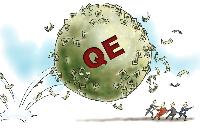
Conventional monetary policy
How a central bank like RBI’s monetary policy can influence the economy? It is through interest rate. The central banks now have a powerful monetary policy weapon in short term interest rate. In India, this short term interest rate or ‘the policy rate’ is the repo rate.
When the RBI reduces its policy rate or repo rate, commercial banks also reduces their lending rates. As a result of this general decrease in interest rate, loans taken by households and businesses goes up and thus economic activity and growth enhances. This is the way in which the RBI can stimulate the economy.
Why unconventional monetary policy?
But in the advanced countries, especially in the US, the policy rate was very low during the financial crisis. The situation is known as Zero Bound Rate ( a situation of interest rate being already very low).
This means that the Federal Reserve is not able to stimulate economic growth by reducing the interest rate further. It has to find some other way to influence the market interest rate.
For this, the US Federal Reserve has adopted a unique and rare policy measure to bring down the overall interest rate during the post crisis period (after 2007). This policy is known as unconventional monetary policy and is explained below.
Here, the Fed has purchased large quantities of bonds issued by government and private parties. This bond purchase produces higher demand for bonds. The issues of these bonds were able to reduce interest rate offered by them on the newly issued bonds. For them, reduction in interest rate will help as it implies low cost of borrowing.
But for the economy as a whole, when the central bank purchases huge quantities of bonds from the market, reduced bond interest rate (yield) also brings reduction of interest rate in other loans including the loans given by banks.
In this way, a bond purchase programme enables the US Fed to bring down the overall interest rate in the economy. This is called the unconventional monetary policy. Here, the central bank doesn’t use the repo or short term interest rate. Rather, it influences the interest rate through bond purchase.
What is unconventional monetary policy?
According to RBI’s Deepak Mohanty, “When central banks look beyond their traditional instrument of policy interest rate, monetary policy takes an unconventional character.”
In the US, the unconventional monetary policy took the form of Quantitative Easing (QE). Under QE, the US Fed purchased big volume of bonds from banks. Bonds purchased by the Fed adds to its assets. These assets are equally matched by corresponding money flow into the economy. Or in other words, when the Fed purchases bonds, its asset holding increases, at the same time, it expands money supply. This is because, for bonds, the Fed gives cash to the banks. The net effect is that the interest rate in the economy comes down along with increased money supply (with banks). This is the unconventional monetary policy adopted by the US Fed and it has started exit from this policy on 16th December by increasing the Fed rate or its policy rate by 25 bps.
*********









